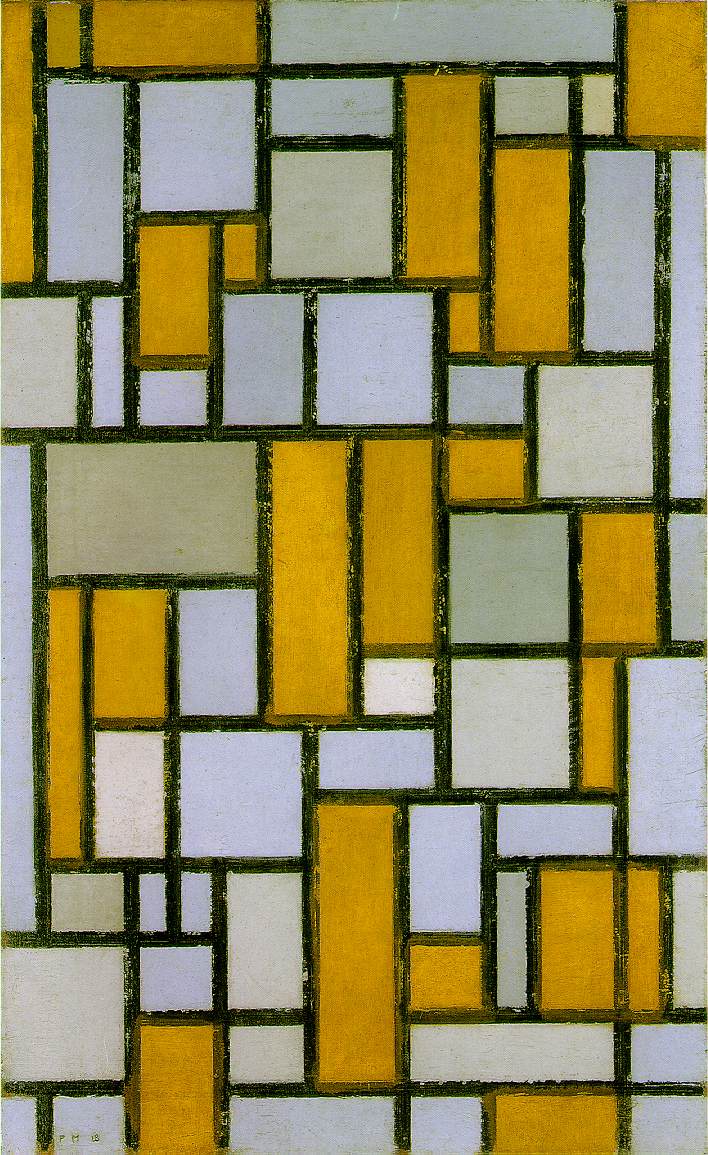"Everything was spotless white, like a laboratory. In a light smock, with his clean-shaven face, taciturn, wearing his heavy glasses, Mondrian seemed more a scientist or priest than an artist. The only relief to all the white were large matboards, rectangles in yellow, red and blue, hung in asymmetric arrangements on all the walls. Peering at me through his glasses, he noticed my glance and said: "I've arranged these to make it more cheerful! (Visiting Mondrian)
I like painters that are progressive in their art. Painters that evolve as their life and surroundings change over the years. Painters that are naked and not afraid to show this on canvas.
One such a painter is “Piet Mondrian” (or “Mondriaan”) who changed his style many times as he traveled from the Netherlands over Paris and to New York. Starting as an naturalist or impressionist, he got his artistic inspiration from typical Dutch landscapes (windmills, flowers etc).
 However his search for simplification, brought him eventually to Paris. Paris at that time (1910) was at the forefront of cubist art. The city has embraced Picasso and Braque and is still considered to be the birthplace of modern abstractism. To emphasize mondriaan’s departure from life in his artistic backwater of the Netherlands, he changed his name (Mondriaan into Mondrian).
However his search for simplification, brought him eventually to Paris. Paris at that time (1910) was at the forefront of cubist art. The city has embraced Picasso and Braque and is still considered to be the birthplace of modern abstractism. To emphasize mondriaan’s departure from life in his artistic backwater of the Netherlands, he changed his name (Mondriaan into Mondrian).During WW Mondrian saw himself forced to go back to the Netherlands, where he founded one of the most influential artistic group in the 20th century – “De stijl”. The movement expressed a new utopian ideal of spiritual harmony and order. The movement's members advocated pure abstraction and universality by a reduction to the essentials of form and colour - they simplified visual compositions to the vertical and horizontal directions, and only used primary colors along with black and white. De Stijl’s influence came from something which Mondrian later described as neoplasticism (i.e. ultimate simplicity and abstraction, both in architecture and painting).

After the ending of WWI, Mondrian returned to Paris, where he would remain until 1938. The intellectual freedom and artistic innovation of post-war Paris, led him to flourish and embrace an art of pure abstraction. It was at this time that Mondrian began producing grid-based paintings, the style for which he late came to be renowned.

In September 1938, Mondrian left Paris in the face of advancing fascism and moved to London. After the Netherlands were invaded and Paris fell in 1940, he left London for New York City. Mondrian work had a great impact on his life, some even caught the painter dancing in horizontal and vertical planes, but never in circles.
If you cant be bothered to read the whole text, below you find a 0.52 seconds movie, which explains the mind and vision of Mondrian
To understand more or to simply lay back and enjoy, watch the beautiful 5 minute movie below.



0 Comments:
Post a Comment